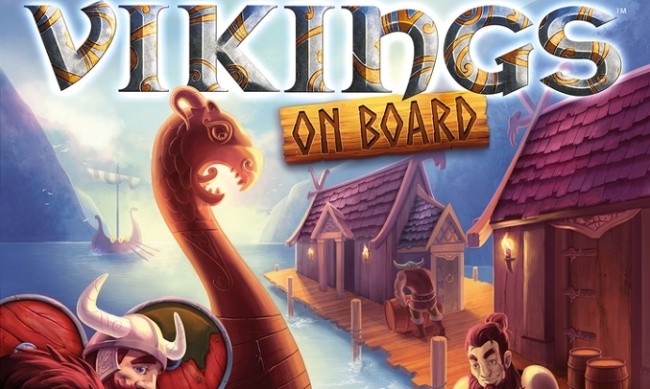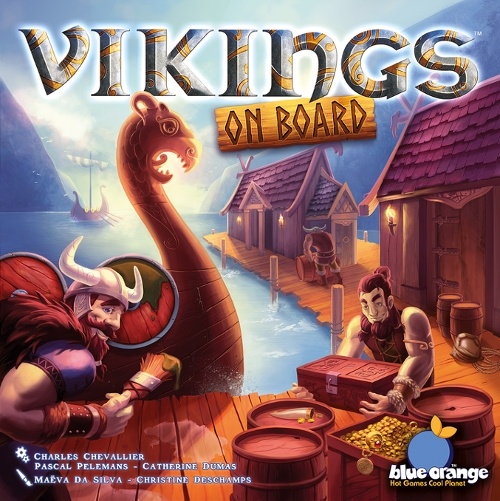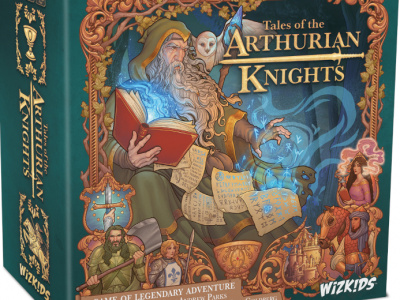Vikings on Board
Publisher: Blue Orange
Release Date: August 2016
Price: $44.99
Game Designer: Charles Chevallier, Catherine Dumas, Pascal Pelemans
Format: Board Game
Number of Players: 2 to 4
Playing Time: 30-60 minutes
Age Rating: 8+
Product #: 04300
ICv2 Rating: 3.5 Stars out of 5
This is a good worker-placement game in which the workers just happen to be Viking warriors. The mechanics of the game involve little Viking ship segments, which, oddly, get moved back and forth between ships to represent various moves made to control the different ships. There are also little Viking figures, which are your "workers." The physical quality of these components is high, and the printing of the board and other components is clear and attractive.
During the course of the game, each player tries to control the ships with the most victory points, and to deny control of the most valuable ships to the other players. While it is possible to play this with only two players, it is much more fun with three or four, because the back-stabbing and maneuvering are the best parts of the game.
Turn order depends on what you did on the previous turn, which is one of the best mechanics in the game. The more powerful your previous move was, the later in the turn that Viking will move on this turn. Since you have a limited number of plays per turn, this is the main cause of slow play in the game, as you try to plan for not only this move, but the one ahead. Even for experienced gamers, 30 minutes is unlikely for their first few plays of this game. 60 minutes is quite realistic, though.
Each turn, you place Vikings on positions in the port allowing you to take specific actions, ranging from altering the composition of a ship’s crew relative to other players to adding goods to a ship, to launching a ship. The actions are resolved in a fixed order, which also affects the next turn’s order. You can alter the value of goods to be carried, alter the next turn’s worker placement order, or take other actions, but each action can only be taken by one worker on a given turn. If another player moves before you and grabs the action you want, you can get frozen out of plan A very easily, so always have a plan B.
Some of the victory points come from placing bets on who will actually control a ship by the time it gets launched. Successful bets provide a significant percentage of the overall victory points, so this can be very important.
One minor weakness is in the setup. You have to randomize the ship segments, but the rules don’t suggest a mechanism for doing this. Basically, you need the equivalent of a sorting hat, some kind of drawing bag where you can pull segments without seeing them. So, game owners will have to figure out their own way of achieving this.
In the 3-player variant, all the active players are playing against a dummy player, but in practice it’s easy to disable the dummy player early in the game. Unless one of the active players is being weird and contrary, the dummy player is never an actual threat to win, but instead just a minor obstacle to be worked around.
In the 3-and 4-player versions, the game rewards clever combinations of actions from the very beginning, and the player who best figures out two-turn combinations of actions will usually come out ahead. There are very few victory points awarded in the game, and thus the game can be decided by a single clever play, such as hijacking a rich ship just as another player has gotten it ready to launch, while having bet on yourself as the ship’s controller.
The components are very well crafted, especially the ship segments, but if you ever lose or damage a single ship piece, it will be hard to create a replacement. So, don’t let your pets near this one even for an instant.
--Nick Smith: Librarian Technician, Community Services, for the Pasadena Public Library in California.

ICv2 Stars: 3.5 (out of 5)
Posted by Nick Smith on November 15, 2016 @ 3:59 am CT
MORE GAMES
For Fall
April 26, 2024
WizKids will release a new range of Critical Role Unpainted Miniatures for Fall.
With Excalibur and Holy Grail Promo Meeples
April 26, 2024
WizKids will release Tales of the Arthurian Knights, a standalone sequel to Z-Man’s Tales of the Arabian Nights, with Excalibur and Holy Grail Promo Meeples with every case.
MORE REVIEWS
ICv2 Stars: 3.5 (out of 5)
February 23, 2024
Here's a review of The Lucy Poor graphic novel, published by Iron Circus.
ICv2 Stars: 4 (out of 5)
February 20, 2024
Here's a review of Nina Simone in Comics, published by NBM Publishing.








